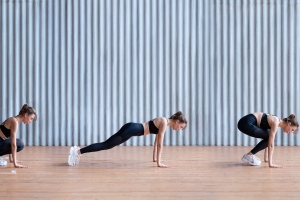

Squatting is a strengthening exercise. Steadily including different squat variations to your weight gain exercise routine can help you maximize your workout output. Squats basically involve lowering the hips from a standing position to get back to standing again. Just like push-ups that help add weight to the upper body, squats are ideal for thigh muscles, and butt area. You can easily trust squats for weight gain because with this exercise, your muscle mass increases (which is heavier than body fat). This is complemented with a perfect body shape.
Depending upon your fitness and weight goal, you can steadily upgrade from the basic form of weight gain exercise to intense variations. Read through to know about the correct squatting posture and the different squat variations that can level up your workout besides making it more interesting.
Right Way to Do Squats for Weight Gain
To reap maximum benefits from this weight gain workout, doing it correctly is the key. For squats, proper standing posture before you get down is important. Here is the step-by-step guide that will help you get started:
1. Standing Position
- Keep your feet shoulder-width apart with slightly bent knees. Make sure your shoulders are directly over your hips with a comfortable head and neck position.
- The chin should remain tucked throughout the workout.
- Distribute your body weight equally and grip the floor steadily with your feet to create a stable position.
- The arms must be placed by the sides.
- Keep your ribs down and your pelvis tucked.
2. Downward Movement
- Maintain your balance and alignment as you begin your downward movement. Bend your hips, knees, and ankles and allow your arms to swing forward as you push your hips down into the squat position.
- Keep lowering your body until the thighs come parallel to the floor. Keep lowering till you can maintain a pelvis level. Hold this position for a second.
3. Upward Movement
- To begin the upward movement, push the feet downwards into the ground to initiate a standing-up stance. The emphasis should be on pushing through the midfoot and heel as the toes are kept engaged to the floor.
- Hold your chest high and squeeze the glutes. Focus on straightening your knees as you allow your hips to move forward. Your arms will now move back to your sides.
As you finish each weight gain workout squat, squeeze the glutes and quadriceps as you reach a comfortable spine position. Remember, your shoulders must finish directly over the hips.
Variations to Raise Complexity of Squats
There are several ways to do weight gain exercise at home. From the basic squats to squats with equipment, the levels can be raised to enhance complexity and the resultant weight gain and muscle-building benefits.
Types of Squats
The squatting exercise can be categorized and modified into four types:
1. Bodyweight Squats
As the name suggests, bodyweight squats do not require any additional weight or equipment and primarily use your body weight. Interestingly, lots of variations are possible in bodyweight squats:
Basic Squat: Get into the squat position mentioned above and get started.
Wall Squat: Have knee or hip problems? Try the wall squat for extra support to the spine. Stand against a wall with your feet around 12 inches out from the wall. Start the downward movement as you slide your back against the wall. Bring your thighs parallel to the floor before initiate the upward movement.
Prisoner Squat: Position your hands behind your head as you take your squat position. Gently move downwards and upwards, concentrating on your core.
Single-Leg Squat: To start the weight gain workout, get into the squat position with your hands on your hips. As you initiate the downward movement, lift your left leg and push it in front of you. Move downward on your right leg as far as you can go or till it comes parallel to the floor. Switch legs for the next squat.
Pile Squat: Stand with your feet wider than shoulder-width with toes pointing sideways. Keep your hands on your hips and start the downward movement. Bend down till the thighs are parallel to the floor. Keep your back straight and chest up throughout the downward and upward movement.
Side Kick Squat: Stand in the regular squat position with your fingers interlaced and hands under your chin. Start the downward movement. As you come up gently, shift your weight on one leg, kicking with your other leg sideways. Switch legs with every squat.
2. Weighted Squats
Adding weight can level up your weight gain workout. Dumbbells, a kettlebell, or a barbell are typically used for weighted squats. The modification includes:
Overhead Squat: Get into the squat position with a weight held overhead. Keep your elbows straight. Move downwards into the squat position until the thighs come parallel to the ground. Initiate the upward movement by pushing the heels towards the floor.
Barbell Back Squat: Load a barbell with appropriate weights and place it on your shoulders. Complete the basic squats.
Dumbbell Squat: Hold dumbbells of equal weight in both hands. Get into the squat position and complete the basic squats.
Goblet Squat: Hold a kettlebell or a dumbbell of appropriate weight in front of your chest. Stand in a squat position and lower yourself until your thighs come parallel to the ground. Start the upward movement by pushing your heels against the ground.
Bulgarian Split Squat: With dumbbells in your hands, stand in front of a low-height stool with your right foot placed on the stool. Start the downward movement with the left leg. Squat down comfortably and get back to the standing position by pushing through your heel. Switch legs and perform on the other side.
3. Plyometric Squats
A combination of speed and strength, plyometric squats are much preferred among fitness enthusiasts, athletes, and bodybuilders as an effective weight gain exercise at home. But if you are new to working out, it’s better to go slow as plyometric squats are rough on joints. The variations in plyometric squats include:
Jump Squat: Stand in the squat position and initiate the downward movement. As you begin the upward movement, jump on your toes to get up. Land softly and get back to the downward movement again.
Weighted Jump Squat: Add weights to the jump squat for added muscle strengthening and resistance.
4. Squats with Equipment
While squatting is a simple no-equipment, weight gain exercise at home, you can maximize your workout by complementing it with basic gym equipment. Interestingly, squats with equipment can also be used by beginners who are yet to master the art of squatting right. The weight gain exercises for squats with equipment include:
Wall Squat with Yoga Ball: Start the wall squat as mentioned above after placing a yoga ball between your back and wall. Press against the yoga ball and roll it up and down as you squat.
Bench Squat: For beginners who find it hard to assess how low to go in the downward movement, starting with a bench squat can prove to be helpful. Position yourself in front of a low bench. As you start the downward movement, get down till your bottom touches the bench lightly. Without sitting, get back to standing up.
Mini Band Squat: Proper squatting position requires keeping the knees out. But people with weak glutes are unable to observe this. Using a mini band is helpful in such cases. Placing a mini band above your knees in a basic squat position ensures that your knees do not cave in, helping you squat right for the weight gain workout.
Box Jump to Squat: Position yourself behind the box. Initiate the downward movement and jump up, landing softly on the box. Complete your squat on the box. Get down gently and repeat the weight gain workout.
Resistance Band Squat: If the use of weights is putting pressure on the joints, the use of resistance bands is recommended. Stand on the resistance band, holding the ends at your waist. Perform the basic squat without moving your hands.
Conclusion
If you are looking to improve your lower body fitness, squats can do the wonder trick. When performed correctly, squats work on a range of lower-body muscles including the quadriceps, hamstrings, glutes, abdominals, and calves. Thus, the easy weight gain exercise helps you add the required muscle mass, giving that perfectly contoured lower body.
But if you have a pre-existing medical issue, consult a medical practitioner before beginning the squats for weight gain. Also, gradually include different squat variations to level up your workout. However, the key is to pay attention to your body and stop immediately in case of discomfort or pain. Don’t forget to incorporate a proper warm-up, rest, and nutrition into your weight gain exercise program.




